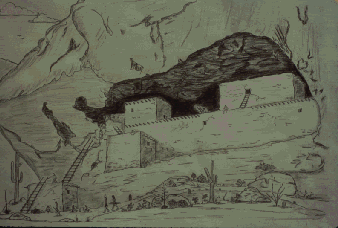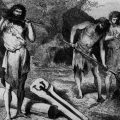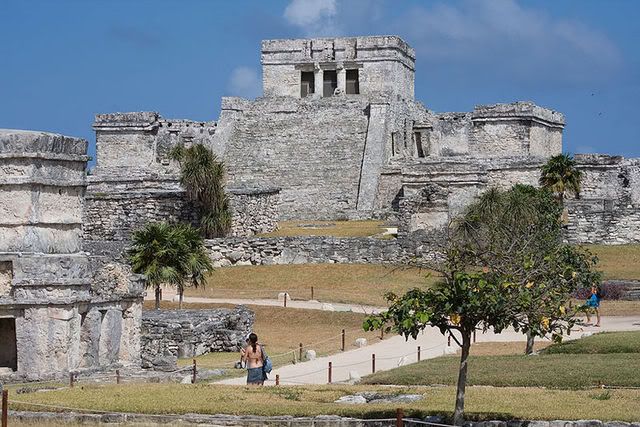( – promoted by navajo)
Two thousand years ago, the Indian people who were living in the Tonto Basin area of Arizona were sophisticated gathering and hunting people. In addition, they were also raising a few crops, primarily corn with some beans and cotton. Like other hunting and gathering people of this time period, they did not live in isolation, but had wide-spread interactions with the other Indian people of the Southwest.

Genetically, these early Tonto Basin residents were related to the Sinagua People and the Ancestral Puebloan People to the north.
About 1,300 years ago things began to change in the Tonto Basin. Hohokam colonists from central Arizona-from the area around present-day Phoenix-started to move in. The indigenous settlement densities at this time are fairly low and so the new Hohokam colonists did not displace any of the indigenous groups nor did it appear to create any conflict with them.
The Hohokam colonists established their own communities with their distinctive architectural style. Unlike the Hohokam in central Arizona, however, they did not build ballcourts-the large sunken playing fields similar to those found farther south in Mexico which are so characteristic of the Hohokam.
The reason for the migration from the Phoenix area into the Tonto Basin can be summarized in a single crop: cotton. The indigenous people living in the Tonto Basin began raising cotton nearly 1,900 years ago. Cotton is strong, lightweight, and durable. It is relatively easy to grow, harvest, and process.
Archaeologists have noted that cotton was an ideal crop for the Tonto Basin farmers and for this reason farmers from other areas, such as the Phoenix Basin, came to the Tonto Basin for the express purpose of growing this crop. The newly arrived farmers focused on cotton even at the expense of growing food crops.
One of the reasons for cotton’s importance to these early farmers was cotton’s role in religious ceremonies. This is still seen today in modern Pueblo groups, such as the Hopi, where cotton is used in all articles of dress associated with ceremonies. This includes kilts, sashes, and belts. At death, unspun cotton is placed across the face of the deceased to represent clouds.
About 1,000 years ago Indian people in the Tonto Basin area had developed an intensive cultivation of cotton and corn. They were also raising a variety of squashes, jack beans, common beans, and possibly growing grain amaranth and little barley. They were also continuing to gather some wild plant foods, including prickly pear fruit and pads, cholla buds, saguaro fruit, cattail, grasses, and sunflowers. They were hunting both cottontail rabbits and jackrabbits as well as some deer.
Between 850 years ago and 650 years ago there was a second major influx of immigrants into the Tonto Basin. These new immigrants were Ancestral Puebloans from the Colorado Plateau to the north. These new immigrants did not establish new communities, but moved into existing communities. Unlike the Hohokam, who moved in community-sized groups, the Ancestral Puebloans appear to have moved in smaller groups such as households.
About 650 years ago there were a number of major changes in the Tonto Basin. This marks the beginning of what archaeologists call the Roosevelt Phase which is characterized by some new architectural forms and some new artifacts. This Phase is considered to be the classic development of what archaeologists call the Salado Culture. The Salado Culture combines many of the elements of other Southwestern Cultures: Ancestral Puebloan, Hohokam, Mogollon.
Using rocks cemented together with mud, the Salado people built apartment-type houses called pueblos. Many of these were two stories high and some were as high as four stories.
In the Southwest, a long period of drought began in the year 1275. As a result of this drought, many areas were abandoned except for spring oases. While some people may have left the area entirely, it seems that the majority gravitated toward the existing settlements along the rivers. It was in these settlements that they would have the strongest kinship ties and best hope for assistance.
Platform mound architecture and the appearance of a type of pottery known as Roosevelt Red Ware began in the Tonto Basin about 1280. The building of platform mounds appears to be related to the beginning of the long drought in the Southwest, a time when people were abandoning the upland areas for settlements along the more reliable river water sources. For people moving from the upland areas devastated by the drought, the availability of dependable water was undoubtedly one factor in choosing to move to the settlements in the Tonto Basin.
The platform mounds were adapted from the Hohokam model. They are associated with a response to: (1) stress on access to arable land created by displaced uplanders moving into established riverine settlements, (2) production stress on the riverine arable land due to the loss of upland agricultural production, and (3) irrigation expansion, intensification, and management needs arising from the first two factors.
The mounds seemed to have served primarily to manage land tenure and access to water, with irrigation simply a means to that end. The mounds were constructed using the additional labor which was now in the region. The additional labor was also used to expand production to meet increased subsistence needs and to move into trade commodity production with crops such as cotton.
The Salado with their surplus crops and cotton became a part of a regional trading network. They traded with neighboring tribes who, in turn, traded with other tribes, and the resulting trade network extended from Colorado to the Valley of Mexico and to the Pacific Ocean.
The mounds integrated several villages. A multi-village community was created which focused on the ceremonial activities at the. The people who actually lived at the platform mounds scheduled the calendrical rites that were performed at these public architectural facilities. In this way, the people who lived at the mound sites maintained religious control over several villages.
Religious ideology was important in bringing the different villages together so that they could perform ceremonies which would help bring the rain and continue to keep the people in harmony with the world – both physical and spiritual – which was around them. The people who lived at the mound sites, however, were distant from other people both in a physical sense and a social sense. These people served as a kind of religious elite and could focus more of their attention on spiritual matters.
Two types of mounds were built in the Tonto Basin during this time. The Meddler-type mound is approximately 25 meters by 20 meters by about 2 meters high. It was made with a lower level of structural cells that were filled in to support two large rooms on top. It is generally believed that this type of mound functioned as the center of ceremonial activities.
Tower mounds, on the other hand, served important communication purposes. From the tower mound, people could signal using smoke, mirrors, and/or fire that it was time to begin a ceremony. At the Pyramid Point site the tower mound is 5.5 meters by 8 meters by 2 meters high. A single room was constructed on top. The mound was contained within a surrounding 15 room masonry compound. This compound served as a residential area as well as a ceremonial area. The small size suggests that the people who lived at this settlement were there primarily to maintain the mound and its facilities.
The mounds in the Tonto Basin, like the Hohokam mounds in Central Arizona, were associated with irrigation, and their inhabitants probably used irrigation management as part of their leadership mandate. However, they were probably built in response to many different governmental and ceremonial organizational needs as they were not required for the operation of the irrigation system per se.
Another distinctive aspect of Salado culture at this time is their pottery. Salado polychrome pottery was widely traded through the region. Rather than black and white paints applied to a red-slipped base, as in other Anasazi polychromes, Salado polychromes have black paint applied to a white-slipped zone (either the interior of a bowl or a portion of the exterior) with no painting in the red-slipped zones. The red clay is tempered with mica flakes giving the surface of the vessel a glittery aspect.
During this time period (1280-1350) the population of the Tonto Basin area doubled. This population growth was partially from natural internal population growth, but it was augmented by immigration from the highlands below the Mogollon Rim, the Colorado Plateau, and perhaps northern Mexico.
There were also important subsistence and settlement changes. Formerly dispersed populations now tended to cluster around platform mounds to form village-sized habitations.
The people were making a greater commitment to agriculture and were expanding their irrigation systems. Their goal was the steady production of cotton fiber and various agave products.
Agave-also known as mescal, maguey, or century plant-is native to the area. Agave fiber can be twisted into strong twine and used for cordage, basketry, and woven textiles, agave sap can be made into fermented beverages like pulque and agave hearts can be roasted and preserved as a sweet and nutritious food, with a caloric content equal to corn.
One of the health problems facing the people at this time was tuberculosis. Archaeologists have found a child who was buried at the Schoolhouse Mound who appears to have had tuberculosis. The burial treatment suggests that this child belonged to a ceremonially important family, or one of the wealthier families that inhabited Schoolhouse Point Mound.
About the year 1325 many of the Roosevelt phase settlements were abandoned and the platform mound system fell into disuse. The period which archaeologists call the Gila Phase began about 1350.
During the Gila Phase, corn and cotton continued to be the major cultigens. There was also an increase in cholla, agave, and cheno-ams which suggests the deliberate cultivation and intensification of the use of these native plants.
Following the Gila Phase, the Indian people of the Tonto Basin began to be impacted by the European invasion of the continent: an invasion which brought with it new diseases-smallpox, measles-as well as many new trade goods, and ultimately new forms of government and religion. During the 20th century, the American government built a dam creating Roosevelt Lake which flooded many of the ancient Salado sites.



Leave a Reply